
Original Link: https://www.anandtech.com/show/2418
Intel's Menlow Revealed: Baby Centrino Gets Ready
by Anand Lal Shimpi on January 9, 2008 12:00 AM EST- Posted in
- CPUs
Despite CES 2008 being all about brand new displays and TVs, we got some of the most interesting information at the show from Intel, about microprocessors.
All smartphones, including the iPhone, suffer from poor performance. These devices all run highly integrated System on a Chip (SoC) designs, where power consumption matters first and foremost, with performance being a distant second consideration. Software compatibility is also a major concern, as the entire world of mobile and smart phones run on a tremendous number of incompatible platforms. A single software application or game must be at least recompiled if not re-written for virtually every single device it's going to go on.
In stark contrast to all of this is the PC; performance is job number one, and only recently has power consumption even begun to factor into the equation. Software compatibility is also ensured thanks to the fact that the x86 instruction set is the de-facto standard in the PC industry.
The problem is that PC system architectures don't translate well into small, ultra low power devices like smartphones. What's necessary is a ground-up design, aimed specifically at those markets. Intel realized this early on in the evolution of mobile processors. In order to make a truly mobile PC, Intel could not simply repackage a desktop/server CPU, it needed something specifically designed for the mobile market. Thus the first Centrino platform was born, and now five years later, we're dealing with a very mature platform.
The need for even more powerful, even more mobile devices is now upon us. The demands we have on our smartphones are ever increasing, we want the functionality of a notebook, but in something the size of an iPhone. It's time for another revolutionary change, akin to what Centrino was for notebooks. Intel learned its lesson with Centrino, which became a very successful brand for the company. Now Intel hopes to go above and beyond what Centrino ever was, for ultra mobile devices.
It all started with devices like the Portable Media Center and the Ultra Mobile PC (UMPC), devices designed to bring certain features of your PC with you on the go, without the bulk of a notebook. The interface was also supposed to be mobile optimized; just as Microsoft discovered with Media Center and as Intel did with Centrino, in order to make an ultra mobile device work, it could not simply use the same interface as a desktop OS - it needed something new and specialized.
Unfortunately, these devices failed miserably. They were either too big, too expensive, too slow or too impractical to use. The reasons for their failure were simple: the hardware wasn't fast enough and the software was too slow. UMPCs were the perfect example; most of them run Vista, but they don't have the hardware to run it fast enough to be usable and since they use components designed for much larger notebooks, battery life suffers greatly. The level of integration on the silicon side is also a problem; these UMPCs are far too big.
Apple realized these problems early on, and didn't jump on the UMPC bandwagon. Instead, it created a mobile-optimized OS and stuck it on a smartphone. The end result was that the iPhone was born with the most elegant smartphone interface onthe market. However, Apple used mostly off the shelf components for the iPhone, so despite its speedy interface, the phone itself could still benefit from a faster processor. The iPhone is also Apple's only non-x86 product in its current lineup, meaning that software portability between the iPhone/iPod, the Apple TV and its Macs isn't ideal.
Intel came to its senses around the same time as Apple, but instead of building a killer device with the components available on the market today, Intel set out to do for ultra mobile devices what it did for notebooks with Centrino. The platform is codenamed Menlow, and we finally have more details on it.
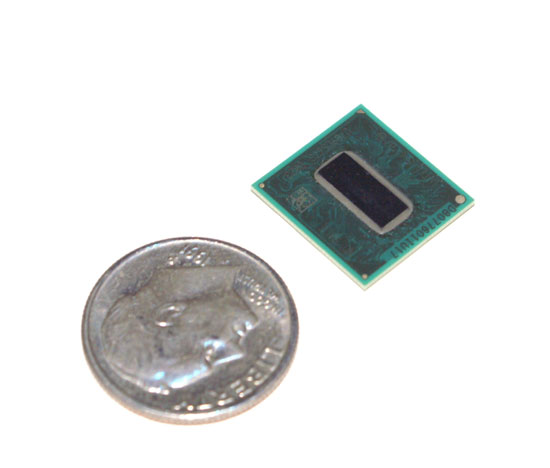

You can see the chip in the picture above; it's tiny. Because of its size you can guess that it's not a very complex core, and not full of cache, despite the obvious reductions in hardware Intel promises that Silverthorne will offer performance comparable to its 90nm Pentium-M from 2004.

We asked for clarification on these performance expectations as this wasn't the first time we'd heard it from Intel. What we got was a promise that Silverthorne, at launch, will be available in clock speeds that the Pentium M was in 2004 and at comparable performance levels as well. Looking back at our original review of the 90nm Pentium M from 2004 we see that the chip launched at frequencies ranging from 1.0GHz up to 2.0GHz. Intel actually had Silverthorne running at its CES booth, at clock speeds ranging from 600MHz to 1.6GHz.
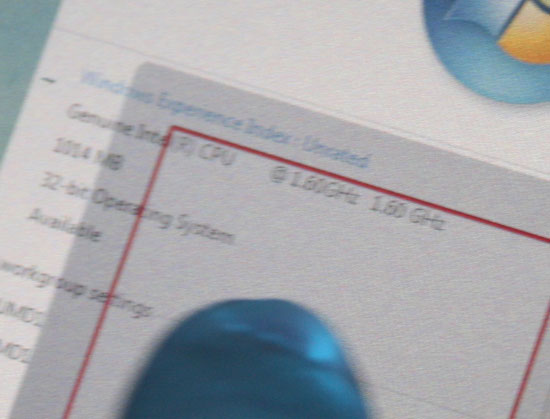
Intel is targeting 10x lower power than its current ultra low voltage processors, meaning a TDP of 0.55 - 0.6W. These TDPs will be possible at the low end of the clock speed spectrum, which so far means 600MHz. The higher clocked parts will obviously consume more power, but Intel says that it'll still be significantly less than 5.5W.
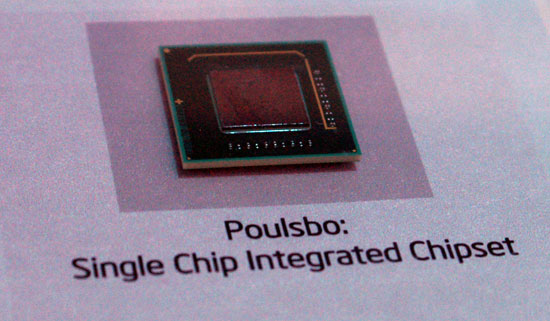
While Silverthorne is built on a 45nm process its chipset, Poulsbo, isn't. We couldn't get confirmation on the manufacturing process but we'd suspect that it's at least 65nm, resulting in a much larger die than the Silverthorne processor itself as you can see from the pics above.
Menlow Based MIDs
Intel told us that 80 - 90% of these MIDs will be Linux based, only a small percentage will run Vista. The Linux MIDs will have their own custom interfaces, similar to what Apple did for the iPhone, in order to improve usability and keep performance up on these lightweight platforms.

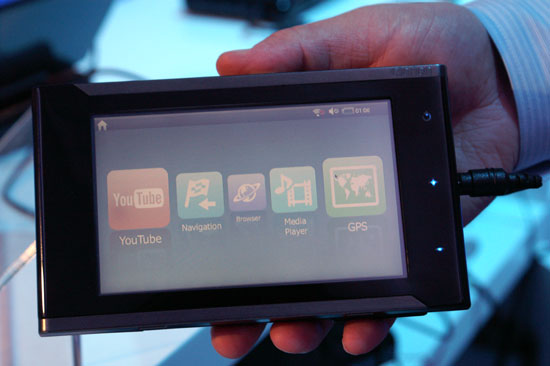
We weren't impressed at all with the MIDs we saw at the show. The ones that ran Linux had decent interfaces but they weren't anywhere near as smooth or intuitive as what Apple created for the iPhone. While these devices are aimed at a very different market, it doesn't mean that the companies making them can't learn from what Apple has done already.
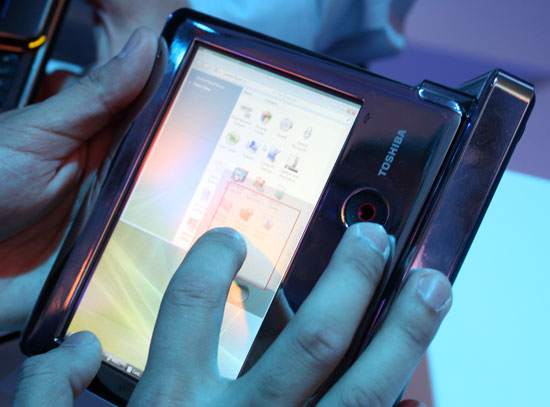
Manufacturers still have a few months to work out the kinks, and Intel is confident that there will be some gems among these first Menlow based MIDs, but we remain skeptical.
Taking on ARM with Moorestown
While Menlow uses a more traditional PC setup (cpu + chipset), its successor due out in 2009/2010 won't. Moorestown, like Menlow, is a two-chip design - composed of a north hub and a south hub. The north hub features the CPU, memory controller and graphics, while the south hub is just I/O. This should sound a lot like AMD processors today, but there's one key differentiator: the south hub won't support the PCI bus.
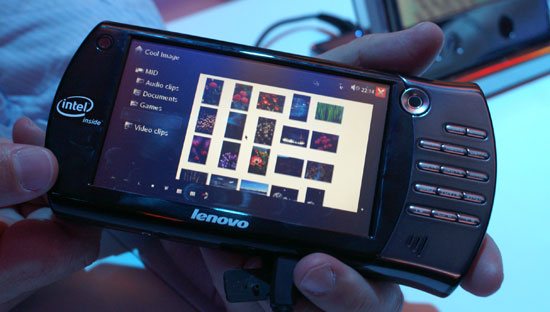
The lack of PCI support is purely a power savings measure; while Intel expects Menlow to be far faster than the ARM platforms used in smartphones today (approximately 2x the performance of what's in the iPhone), ARM will continue to have a significant power consumption advantage.
While there will still be some Menlow devices that run Windows, Intel expects all Moorestown devices to run Linux.
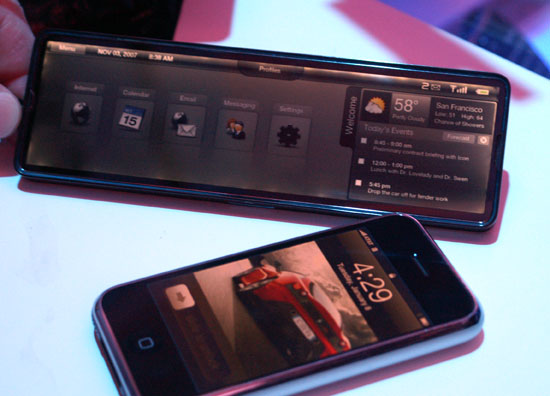
Intel expects that in 2 - 3 years, thanks to reduction in die size and thermals, that it will be in a device the size of the iPhone. Until then we'll have to deal with larger MIDs for Menlow and the candy bar form factor we saw at last year's IDF.
Final Words













